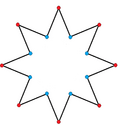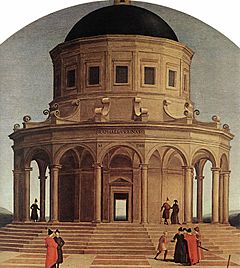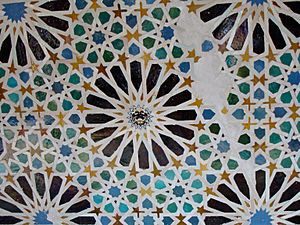Hexadecagon facts for kids
Quick facts for kids Regular hexadecagon |
|
|---|---|

A regular hexadecagon
|
|
| Type | Regular polygon |
| Edges and vertices | 16 |
| Schläfli symbol | {16}, t{8}, tt{4} |
| Coxeter diagram | |
| Symmetry group | Dihedral (D16), order 2×16 |
| Internal angle (degrees) | 157.5° |
| Dual polygon | Self |
| Properties | Convex, cyclic, equilateral, isogonal, isotoxal |
An hexadecagon (say: hex-uh-DEC-uh-gon) is a flat shape with 16 straight sides and 16 corners. It's also sometimes called a hekkaidecagon. Like all polygons, it is a closed shape made of straight lines.
Contents
Regular Hexadecagon
A regular hexadecagon is special because all its 16 sides are the same length. Also, all its 16 corners (angles) are the same size. You can think of it as a perfectly balanced 16-sided shape.
It can be made by "truncating" (cutting off the corners of) an octagon. This means you start with an octagon and cut off each of its 8 corners. This creates 16 new sides.
Area of a Regular Hexadecagon
The area of a regular hexadecagon tells us how much flat space it covers. If you know the length of one side, you can calculate its area.
A regular hexadecagon fits inside a circle (called its circumcircle). It fills up about 97.45% of the space inside that circle. This means it's very close to being a perfect circle.
Dissection
Dissection means cutting a shape into smaller pieces. A regular hexadecagon can be cut into 28 smaller shapes. These shapes are 4 squares and 24 rhombs (diamond shapes).
This idea comes from a mathematician named Harold Scott MacDonald Coxeter. He showed how many-sided shapes can be broken down into these simpler parts.
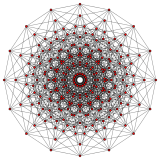 |
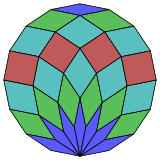 |
Skew Hexadecagon
A skew hexadecagon is a shape with 16 sides and 16 corners, but it is not flat. Instead, its corners zig-zag between two parallel flat surfaces. Imagine a spring or a spiral staircase; its edges would form a skew polygon.
A regular skew hexadecagon has all its edges the same length. It also looks the same from every corner. You can see these shapes in the edges of certain 3D objects. For example, the edges of an octagonal antiprism form a regular skew hexadecagon.
| {8}#{ } | { 8⁄3 }#{ } | { 8⁄5 }#{ } |
|---|---|---|
 |
 |
 |
| These shapes are seen as zig-zagging edges of different types of octagonal antiprisms. | ||
In Art
Hexadecagons have appeared in famous artworks.
In the early 1500s, the artist Raphael drew a building with 16 sides in his painting The Marriage of the Virgin. This was one of the first times a 16-sided tower was shown using perspective. He was inspired by an earlier painting that showed an eight-sided tower.
You can also find 16-sided star patterns, called hexadecagrams, in the beautiful Girih patterns at the Alhambra palace in Spain.
Irregular Hexadecagons
An irregular hexadecagon is a 16-sided shape where the sides are not all the same length. Also, its angles are not all the same size.
An octagonal star is an example of a concave hexadecagon. Concave means it has at least one angle that points inwards, like a cave. 